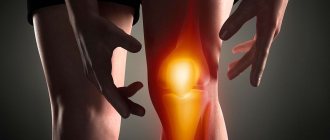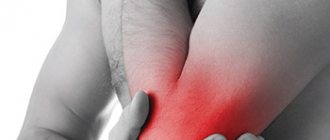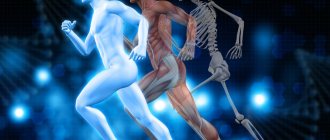Manufacturer: SC Terapia SA
Active ingredients
- Not indicated. See instructions
Pharmacological action
- Not indicated. See instructions
- Description of the pharmacological action of Artroflex
- Composition of Artroflex
- Indications for use of the drug Artroflex
- Release form of the drug Artroflex
- Use of the drug Artroflex during pregnancy
- Contraindications to the use of the drug Artroflex
- Method of administration and dosage of the drug Artroflex
- Precautions when taking the drug Artroflex
- Storage conditions for the drug Artroflex
- Shelf life of the drug Artroflex
Description of pharmacological action
Glucosamine and chondroitin sulfate sodium are involved in the biosynthesis of connective tissue, prevent the processes of cartilage destruction and stimulate the regeneration of cartilage tissue. Glucosamine - 2-deoxy-2-amino-D-glucose - stimulates the synthesis of proteoglycans (glucosaminoglycans and hyaluronic acid) of synovial fluid by chondrocytes; inhibits enzymes (collagenase, phospholipase A2, etc.) that cause destruction of cartilage tissue; suppresses the activity of lysosomal enzymes; prevents the damaging effect of corticosteroids on chondrocytes and the disruption of glycosaminoglycan synthesis induced by NSAIDs. Glucosamine stops the destruction of cartilage and reduces the symptoms of osteoarthritis. Chondroitin sulfate is a polysaccharide component of cartilage tissue proteoglycans with a repeating disaccharide unit: D-glucuronic acid N-acetyl-D-galactosamine sulfate. Participates in the construction of the basic substance of cartilage and bone tissue, inhibits enzymes that disrupt the structure and function of articular cartilage, and inhibits the processes of degeneration of cartilage tissue. Stimulates the synthesis of glycosaminoglycans, promotes the regeneration of cartilage surfaces and joint capsule, increases the production of intra-articular fluid of the joints. Reduces associated inflammation, pain and increases mobility of affected joints. Clinical studies have confirmed that the combination of glucosamine and chondroitin enhances the positive effect on joint diseases.
The use of Teraflex in the complex therapy of osteoarthritis. A neurologist's view of the problem
According to modern concepts, OA is based on many endogenous and exogenous factors. The former respectively include age, gender, developmental defects, hereditary predisposition, and the latter – injuries, professional activity, sports activity and excess body weight. Since many risk factors are not modifiable, OA tends to progress to disease progression [1,4]. There are 2 main forms of OA: primary (localized or generalized) and secondary (post-traumatic, caused by congenital, metabolic, endocrine and a number of other diseases) [9,12]. The key pathogenetic mechanism of osteoarthritis is dystrophic changes in articular cartilage and its premature wear. Cartilage is a type of connective tissue and is a rigidly organized spatial structure of non-cellular matrix and cellular elements that covers the articular surfaces of the bones included in the articulation and provides their “soft” biomechanics due to shock absorption and smooth sliding relative to each other. This is one of the most vulnerable places of the musculoskeletal system (MSA). In the USA alone, about 40 million people are annually registered with diseases of the musculoskeletal system such as arthrosis, arthritis, tendovaginitis and bursitis. If we talk about osteoarthritis, its causes are dominated by severe simultaneous trauma with bruises, fractures, dislocations and/or damage to the ligamentous apparatus of the joint, or repeated microtrauma to the joint. Examples include arthrosis of the knee joints in miners and football players, elbow and shoulder joints in those working with jackhammers, ankle joints in ballerinas, and arm joints in boxers. OA has a significant prevalence, especially in older age groups, where its frequency exceeds 50% [20]. According to epidemiological data, 20 million adults in the United States have OA diagnosed by doctors [12]. The importance of the treatment of osteoarthritis is due not only to its high prevalence, but also to the social problems that the disease causes in the patient: a sharp decrease in physical activity leads to a pronounced decrease in the quality of life, social maladaptation, loss of ability to work, and in advanced cases, the ability to self-care. In addition, the trend of population aging leads to the fact that the number of patients with osteoarthritis is increasing year by year. Osteoarthritis after 60 years (as an age-related phenomenon) is found in every second person. However, metabolic and circulatory disorders in the extremities, endocrine disorders (for example, diabetes mellitus, thyroid diseases, menopause, genetic disorders) cause its appearance at a much earlier age. Visits to outpatient clinics for diseases of the musculoskeletal system account for up to 10% of all visits. The economic costs of it in Western countries are estimated at 1.5% of GDP. The noncellular matrix is rich in proteoglycans (glycosaminoglycans) glucosamine and chondroitin. In structure, cartilage is similar to a sponge, absorbing in a relaxed state and squeezing the proteoglycan phase of the matrix into the articular cavity under load. Under physiological conditions, renewal of matrix structures due to the absence of vessels in it is supported by active exchange with intra-articular synovial fluid, which contains all the components necessary for this. Intra-articular synovial fluid simultaneously acts as a “lubricant” for the moving parts of the joint. The ability of cartilage to withstand high dynamic and static loads is a function of the structure of the matrix and its high-quality self-renewal; in this case, the high concentration of proteoglycans in the matrix and synovial fluid plays an exceptional role. Any pathological phenomena in the joints is associated with dystrophic (in milder cases) and inflammatory (in more severe cases) changes in cartilage tissue and intra-articular synovial fluid, leading to degradation of the matrix. The cartilage loses its elasticity and continuity, thins unevenly, and deep cracks form in it. The growth of cartilage tissue along the edges, which do not bear physical load, causes joint deformation. As the process progresses, these phenomena intensify, and more and more new joints are involved. In the modern treatment regimen for osteoarthritis and other joint diseases, an important place is given to chondroprotectors. Along with nonsteroidal anti-inflammatory drugs (NSAIDs), they are the basis of the therapeutic approach in patients with osteoarthritis. The action of these drugs is based on an attempt to influence the composition of the synovial fluid. The fact is that with the development of osteoarthritis, clusters of pathological chondrocytes contribute to the production of inferior basic substance of cartilage tissue, which becomes partially depolymerized, with a reduced content of proteoglycans. The content of the latter determines the “lubricating” properties of the joint fluid, which is “squeezed out” from the cartilage matrix when the mechanical loads on the joint increase. Defective synovial fluid is no longer able to qualitatively support the participation of cartilage in articular biomechanics. Thus, the main link in the pathogenesis of degenerative changes in joints is a change in the quality and deficiency of proteoglycans, which consists in the depolymerization of protein-saccharide complexes with the formation of smaller compounds that leave the cartilage. At the same time, the function of chondrocytes is also impaired, they synthesize less stable proteoglycans, and a loss of physiological properties of cartilage develops, which is accompanied by the formation of erosions and cracks in the cartilage. At the same time, the amount of hyaluronic acid in the synovial fluid decreases, which is an important factor in chondroprotection. Drugs with chondroprotective properties are conventionally divided into three subgroups: drugs - mucopolysaccharides (a type of replacement therapy), stimulators of proteoglycan synthesis and others, including combination drugs. The main chondroprotectors are glucosamine and chondroitin sulfate. Natural components of articular cartilage, they are part of the proteoglycans of cartilage tissue. Glucosamine and chondroitin sulfate have been used in the treatment of osteoarthritis and related diseases since the 1980s. They are used as natural metabolites that can have a protective effect on cartilage and ensure the regeneration of the reparative capabilities of chondrocytes. Currently, a significant scientific base has been accumulated, represented by dozens of controlled studies with a high level of evidence 1A–1B, according to the American College of Rheumatology (ACR) 2000, 2005 [3,9]. Stimulators of proteoglycan synthesis are represented by glucosamine monosulfate. Glucosamine monosulfate is a substrate for the synthesis of proteoglycans by chondrocytes, participates in the synthesis of hyaluronic acid (a substance that ensures the viscosity of intra-articular fluid), and also inhibits the activity of metalloproteinases (collagenase, phospholipase). Thus, the drug has a double effect - anti-inflammatory and chondroprotective. According to available data obtained from randomized multicenter studies, 1500 mg of glucosamine sulfate per day improved the condition of patients during monotherapy, while in cases where the disease occurred with an unexpressed inflammatory component, the effectiveness of glucosamine sulfate was not inferior to that of NSAID therapy. Additionally, data have been obtained to support the presence of an additive effect with the combined use of glucosamine sulfate and NSAIDs. One of the factors determining additivity is the leveling of the adverse effects of NSAIDs on the structure of cartilage. Taking into account compliance with treatment, modern chondroprotective drugs taken enterally are certainly more preferable (glucosaminoglycans generally have high bioavailability and selectively accumulate in the synovial fluid). Taking into account the duration of use of chondroprotectors, enteral forms should be considered significantly more convenient than such “classical” drugs as rumalon and arteparon. Another feature of Rumalon that limits its use is the inappropriateness of prescribing this drug in the presence of an active inflammatory component - Rumalon can enhance the inflammatory response. Glucosamine is an aminomonosaccharide; in the body it is used by chondrocytes as a starting material for the synthesis of proteoglycans, glycosaminoglycans and hyaluronic acid. When taken orally, glucosamine is well absorbed (glucosamine sulfate up to 80%, glucosamine hydrochloride up to 95% due to better solubility); after passing through the liver, about 20–25% of the drug enters the blood. Radioisotope studies demonstrate a clear affinity of glucosamine for joint tissues. About 30% of the administered drug persists for a long time in the connective tissue. Numerous studies of the pharmacological effects of glucosamine have established a beneficial effect on cartilage metabolism - enhancing anabolic and weakening catabolic processes. Glucosamine stimulated the synthesis of proteoglycans and collagen, increased the production of extracellular matrix components, while the properties of glycosaminoglycans and proteoglycans (according to chromatographic analysis) were close to physiological. Glucosamine stimulated the incorporation of 35S4 (a marker of glycosaminoglycan synthesis) into chondrocytes and enhanced the synthesis of glycosaminoglycans in cell culture, and also stimulated in vitro and in vivo the uptake of 35S4 and 3H-proline by articular cartilage. An increase in the synthetic activity of chondrocytes was accompanied by inhibition of chondrolysis due to inhibition of the activity of chondrolytic proteinases (collagenases, etc.). The drug prevented the damaging effects of dexamethasone and some NSAIDs on chondrocytes and the matrix. In these cases, it had a chondroprotective and osteotropic effect, contributed to the normalization of the content of total chondroitin sulfates and alkaline phosphatase activity. Glucosamine exhibits moderate anti-inflammatory effects in various models of inflammation. It is not associated with suppression of prostaglandin synthesis, but is realized through antioxidant activity (by blocking the formation of superoxide radicals) and suppression of the activity of lysosomal enzymes. It has also been established that there is no toxicity or severe side effects of glucosamine, as well as clinical, biochemical or hematological changes with long-term use. Cases of mild side effects, often transient without stopping the drug, were at the placebo level and amounted to about 7% (1–16%) - mild nausea, dizziness, loose stools, etc. In most short-term (4-6 weeks) clinical studies, the effectiveness of glucosamine in doses of 800-1500 mg/day in patients with osteoarthritis exceeded that of placebo and was equivalent to the effectiveness of ibuprofen and diclofenac. Glucosamine was somewhat inferior to NSAIDs in terms of the speed of onset of analgesic and anti-inflammatory effects, but had a clear aftereffect. A noticeable improvement in clinical symptoms appeared 2–3 weeks after the start of treatment, with the effect maintaining for a month or more after discontinuation of treatment, which allows for intermittent courses of treatment. In long-term studies, when therapy with glucosamine at a dose of 1500 mg/day in patients with osteoarthritis continued for 1–3 years, good and excellent results were obtained in 50–60% of patients, satisfactory – in 25–30% of patients. It was noted that in order to clearly assess the results of treatment, glucosamine should be taken for at least 6–12 weeks, which is understandable given the characteristics of the blood supply to the joints and the rate of metabolism in the joint tissues. The group of mucopolysaccharide drugs includes chondroitin sulfate (CS). Chondroitin sulfate is formed in the body from glucosamine; its molecule is 100–200 times larger than its predecessor. The polyanionic molecule chondroitin sulfate is an integral part of the aggrecan structure and is responsible for the physicochemical properties of cartilage. In addition, chondroitin sulfate serves as the basis for the synthesis of hyaluronic acid, which provides lubrication necessary for the functioning of joints. In patients with osteoarthritis, the metabolism of chondroitin sulfate is impaired, the concentration of cholesterol in the synovial fluid is reduced, clusters of pathological chondrocytes produce defective basic substance of cartilage tissue. Pharmacokinetic studies have shown that when taken orally, the bioavailability of the drug is 13–15% (due to the significant size of the molecule). Other studies have found that both the complete form of the drug and its components formed as a result of degradation under the influence of intestinal digestive enzymes are present in the blood. In vivo and in vitro studies concerning the metabolism of externally administered chondroitin sulfate have shown that the drug penetrates the matrix of human chondrocytes without changing the quality of the proteoglycans they produce. Chondroitin sulfate stimulates the synthesis of hyaluronic acid and proteoglycans and inhibits the action of proteolytic enzymes, significantly reduces the activity of chondroitinase in synovial fluid. Chondroitin sulfate has a pronounced tropism for tissues rich in glycosaminoglycans and, in particular, for articular cartilage. It was noted that chondroitin sulfate is also involved in the process of bone mineralization, regulating calcium balance in vitro and promoting ossification processes. Studies on the pharmacological effects of chondroitin sulfate have established the presence of anti-inflammatory activity. An additional factor explaining the anti-inflammatory effect of chondroitin sulfate may be its antithrombotic effect. It has been shown that chondroitin sulfate can prevent the formation of fibrin thrombi in the synovial and subchondral microvasculature due to its structural proximity to heparin. Clinical studies have demonstrated the effectiveness of chondroitin sulfate in terms of its effect on pain and the functional state of joints. The majority of clinical studies that compared the effect of chondroitin sulfate and NSAIDs found that chondroitin sulfate at a dose of 1200 mg/day was as effective as diclofenac and ibuprofen at therapeutic doses, and more effective than placebo in reducing pain and increasing mobility. joints in patients with osteoarthritis. Although the effect of chondroitin sulfate occurred somewhat later (at 6–8 weeks of treatment) compared to the effect of NSAIDs (at 1–2 weeks of treatment), it lasted longer after cessation of treatment). An important advantage of the drug is its good tolerability, side effects when taking it are minor and infrequent - about 1-3% of cases, whereas when taking NSAIDs they are more serious (primarily gastrointestinal bleeding, ulceration, etc.) and occur in 30 –40% of persons. Generally, tolerability of chondroitin sulfate and placebo was similar. In vitro studies have shown that chondroitin sulfate has anti-inflammatory activity, stimulates the synthesis of hyaluronic acid and proteoglycans and inhibits the action of proteolytic enzymes. Clinical studies have demonstrated the effectiveness of cholesterol in influencing pain and the functional state of joints. The use of chondroitin sulfate in a dose of up to 1500 mg per day increases functional activity in patients with osteoarthritis and reduces local pain. Theoretical premises give reason to assume the presence of synergism between chondroitin sulfate and glucosamine in terms of chondroprotective effect. It consists of stimulating the metabolism of chondrocytes and synoviocytes, inhibiting the activity of enzymes that contribute to the degradation of the cartilage matrix, improving the microcirculation of the vascular bed of periarticular tissues (heparin-like effect of chondroitin sulfate). Studies with cell cultures and animal models support this hypothesis. Increased clinical efficacy in the treatment of osteoarthritis with the addition of chondroitin sulfate to glucosamine has been noted in several recent studies. In recent years, in connection with the widespread revision of the evaluation of drugs in accordance with the requirements of evidence-based medicine, a number of modern high-quality trials have been conducted regarding the clinical effectiveness of chondroprotectors. The data obtained indicate that chondroitin sulfate and glucosamine not only have a symptomatic effect, but are also able to have a beneficial effect on the metabolism of cartilage, restoring its structure and normalizing metabolism. Ultimately, these chondroprotectors really have a protective effect in relation to articular cartilage, impede its destruction and contribute (at least partially) its restoration. These data give reason to believe that chondroitin sulfate and glucosamine also have a pathogenetic effect and are able to have a modifying effect on the course of osteoarthrosis. This allows you to expand the range of therapeutic effect of these funds. According to many experts, chondroprotectors with a proven protective effect in relation to cartilage should become the basis of prolonged basic therapy of osteoarthrosis. Analyzing the clinical efficiency and tolerance of chondroprotective agents, the undoubted advantages of sulfate chondroitin and glucosamine should be distinguished as quite effective and safe drugs. Favorable clinical and pharmacological properties of glucosamine make it the drug of choice for basic therapy of osteoarthrosis. The average effective daily dose of the drug is at least 1500 mg per day. Glucosamine treatment makes it possible to get the effect after 2-4 weeks. The use of chondroitin sulfate (its daily dose on average is 1000–1500 mg) is especially indicated in elderly patients with concomitant atherosclerosis, obesity, lipid metabolism, metabolic syndrome, accompanying diabetes due to the presence of antitrobotic heparin -like effect and reduce the level of cholesterol and lipoprothems. Compared to glucosamine, the effect of chondroitin sulfate occurs a little later. Therefore, it is advisable to start therapy with the drug when the expected medical effect can be delayed; Or the pain syndrome should be stopped by the simultaneous reception of NSAIDs. In these cases, a smaller dose of NSAIDs is sufficient. The combined use of chondroitin sulfate and glucosamine provides faster saturation of the body with chondroprotectors compared to the action of one component, as well as a more pronounced clinical effect. Their joint purpose is shown if it is necessary to enhance the action when the effect of one drug is insufficient. This approach makes it possible to reduce the dose of each drug. In the foreground of the treatment of osteoarthritis (2–4 weeks), especially in the presence of pain syndrome, chondroprotectors should be combined with NSAIDs. Subsequently, the dose of NSAIDs can be reduced due to the growing effect of chondroprotectors or NSAIDs can even be canceled. This circumstance allows you to reduce the number of side effects and increase the safety of treatment. The duration of the reception of chondroprotectors, taking into account the features of their action, should be at least 12 weeks. At the same time, as clinical observations show, long (up to 3 years) therapy with chondroprotectors gives the best results. According to clinical indications, an intermittent treatment regimen for 12-16 weeks with a break of 8-10 weeks can be justified. Chondroitin sulfate and glucosamine, used as the basis of prolonged basic therapy of patients with osteoarthritis, can significantly change the course of the disease. Thus, the latest studies have made it possible to confirm all the requirements of evidence -based medicine to confirm the clinical significance of chondroprotectors in the treatment of osteoarthritis. One of the most commonly prescribed drugs of this class is teraflex. It is used for various pathologies of the ODA (supporting and engine apparatus) associated with degenerative changes in cartilage. The composition of the teraflex includes two active ingredients. The capsule includes: Glucosamine hydrochloride 500 mg and sodium chondroitin sulfate 400 mg. Both substances act synergically and directed. They take part in the production of structural elements of cartilage, thereby stimulating its restoration, which is especially important for such severe diseases as osteochondrosis and osteoarthrosis. Also, the components of the drug have a protective effect, preventing the negative effect of destructive factors of both endogenous and exogenous origin. In addition, the teraflex increases the mobility of the joints, reduces the severity of pain, and reduces the stiffness of movements. Teraflex is available in capsules for internal use, as well as in the form of a cream. In the first three weeks, adults and children of the eldest of 12 years are usually prescribed 1 capsule 3 times a day; In the following days - 1 tiraflex capsule 2 times a day. Capsules are taken orally with a small amount of water. The minimum duration of admission is 2 months (if necessary - for a longer time). Literature 1. Alekseeva L.I., Tsvetkova E.S. Osteoarthrosis: from the past to the future // Scientific and practical rheumatology. No. 2. 2009, application. S. 31–37. 2. Badokin V.V., Drezenko A.A., Korsakova Yu.L. Local therapy of osteoarthrosis // attending physician. No. 10. 2007. S. 2–4. 3. Belenky A.G. Hyaluronan preparations in the treatment of osteoarthritis of the knee and hip joints Textbook of GOU DPO RMAPO Roszdrava dated 04.23.2007. 4. Berglezov M.A., Andreeva T.M. Osteoarthrosis (etiology, pathogenesis) // Bulletin of traumatology and orthopedics named after N.N. Priorova. - 2006.– No. 4.– S. 79–86. 5. Vertkin A. L., Taliban O. B. Treatment of osteoarthrosis: the role of chondroprotectors. The attending physician, 09 (2000) 6. Vertkin A.L., Alekseeva L.I., Naumov A.V. et al. Osteoarthrosis in the practice of a therapist // RMG. 2008. T.16. No. 7. S. 478–480. 7. Goryachev D.V. The place of drugs of chondroitin sulfate in the arsenal of agents for the treatment of ostearthrosis // RMG. T.16. No. 10, 2008. S. 3-7. 8. Dzyak G.V. Non-steroidal anti-inflammatory drugs. Kyiv, Morion (1999) Clinical rheumatology. SPb., 2005. S. 386–388. 9. Clinical recommendations. Osteoarthritis. Diagnosis and conduct of patients with osteoarthritis of the knee and hip joints / Ed. O.M. Lesnyak. - M.: GEOTAR - Media, 2006. 176 p. 10. Nasonova V.A., Alekseeva L.I. Arkhangelskaya G.S. and others. The results of a multicenter clinical study of the drug Structure in Russia. New opportunities in the treatment of osteoarthritis and osteochondrosis. M., 2006. S. 5–7. 11. Nasonova V.A., Erdes Sh.F. On the World Decade of Bone Sustody Diseases 2000–2010 // Scientific and practical rheumatology. 2004. No. 4. S. 14–16. 12. National leadership. Rheumatology / Ed. E.L. Nasonova, V.A. Nasonova. - M.: GEOTAR - Media, 2008. S. 573–588. 13. Pavlova V.N., Kapyeva T.N., Slutsky L.I., Pavlov G.G. Cartilage. M.: Medicine, 1998.320 p. 14. Peshekhonova L.K., Peshekhonov D.V., Kuzovkina T.N. The clinical efficiency of chondroprotectors in the complex therapy of osteoarthrosis of the knee joints 1486 breast cancer 15. Rational pharmacotherapy of rheumatic diseases. M., 2003. T.3. S. 143-149. 16. Rudenko V.G. Chondroprotectors - the basis of constructive therapy of joint diseases 17. Chichasova N.V. The place of slow -acting drugs in the rational therapy of deforming osteoarthrosis // Consislium medicum. 2005. T.7. No. 8. S. 634–638. 18. Yabluchansky N.I. Chondroprotectors for all occasions to an article to patient 19. Hochberg MC, Altman RD, Brandt KD AT Al. Guidelines for the Medical Management of Osteoarthritis. Arthritis & Rheumatism, Vol. 38, N11 (1995) 20. Reginster Jy, Deroisy R, Rovati LC, et al. Long -Term Effects of Glucosamine Sulphate OstoArthritis ProgRESSION: A RANDOMISED, PLACEBO - Controlled Clinical Trial. Lancet 357 (2001)
Best before date
12 months
Vitamins with similar effects
- Betulanorm (Capsule)
- For the genitourinary system Life formula (Capsule)
- Coffeeberry (Capsule)
- Sana-Sol - Vitamin C (Oral tablets)
- Pancreavit (Capsule)
- St. John's wort (Oral tablets)
The description of vitamin Artroflex is intended for informational purposes only. Before starting to use any drug, it is recommended to consult a doctor and read the instructions for use. For more complete information, please refer to the manufacturer's instructions. Do not self-medicate; EUROLAB is not responsible for the consequences caused by the use of information posted on the portal. Any information on the project does not replace consultation with a specialist and cannot be a guarantee of the positive effect of the drug you use. The opinions of EUROLAB portal users may not coincide with the opinions of the site Administration.
Are you interested in Vitamin Artroflex? Do you want to know more detailed information or do you need a doctor's examination? Or do you need an inspection? You can make an appointment with a doctor - the Euro lab is always at your service! The best doctors will examine you, advise you, provide the necessary assistance and make a diagnosis. You can also call a doctor at home . Euro lab clinic is open for you around the clock.
Attention! The information presented in the vitamins and dietary supplements section is intended for informational purposes and should not be a basis for self-medication. Some of the drugs have a number of contraindications. Patients need to consult a specialist!
If you are interested in any other vitamins, vitamin-mineral complexes or dietary supplements, their descriptions and instructions for use, their analogues, information about the composition and form of release, indications for use and side effects, methods of use, dosages and contraindications, notes about the prescription of the drug for children, newborns and pregnant women, price and consumer reviews, or you have any other questions and suggestions - write to us, we will definitely try to help you.








